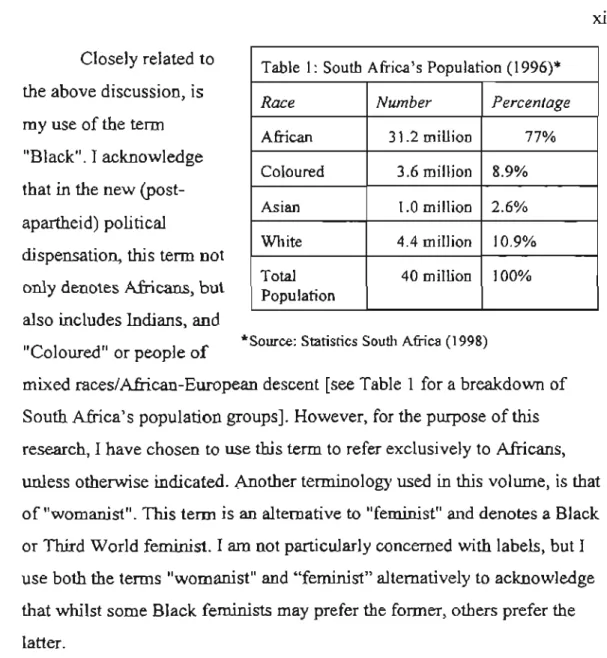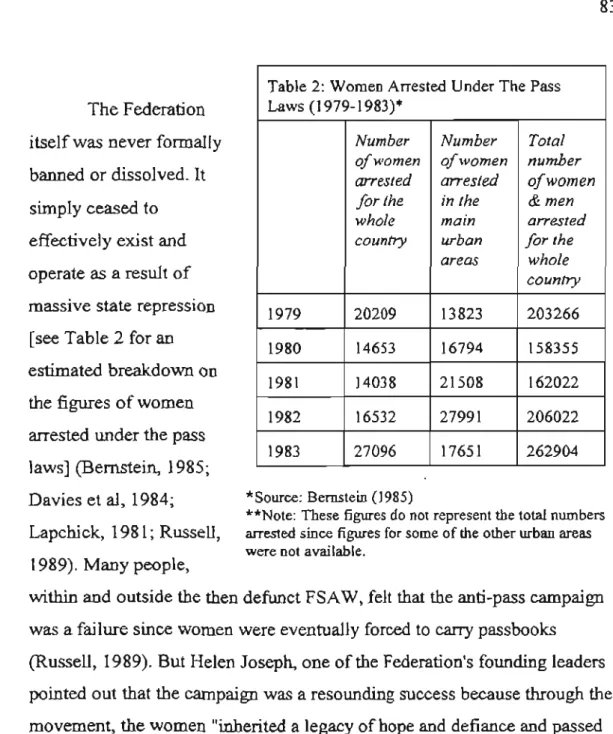The involvement of African women in the national liberation struggle, the migrant labor system and the fight against poverty. As previously mentioned in the introduction, this study is concerned with the politics of survival of African women and how this gives rise to a feminist consciousness.

Writing primarily for an audience of Black women and producing a knowledge that could be of use 10 Black women
The aforementioned authors go on to argue that only such an integrated approach can move us forward in our struggle against ourselves. By writing primarily for an audience of black women and producing an insight that can be useful to 10 black women.
Selecting a representative sample
Not generalizing the experiences of any given group of Black women as representative of all Black women
Liberal feminism attributes the oppression of women to sexism and argues that the gender division of labor and the separation of the public (economic and political) sphere in which men are located. Black/African American feminism is particularly concerned with the oppression of Black women living in the West. American feminism is not entirely applicable to the social reality of women living in the third world, and its theory of the oppression of black women is nevertheless relevant to the oppression of women in the third world.
This means that the same problems perpetuated by colonialism continue to exist in the former colonies.
Oppressive Traditional Practices
Hence African women continue to face the same oppressive socio-economic and cultural subjugation experienced during colonial rule; intensified by increasingly impoverished conditions. According to Dolphyne (1991) and Russell (1989), the practice of bridewealth, in itself, is generally not considered oppressive by African women. Such attitudes leave African women very vulnerable to all forms of spousal abuse with very little recourse, as the bridewealth will have to be returned to the husband's family if she leaves him (Dolphyne, 1991).
Besides the above, there are many other traditional practices that continue to keep African women in subjection. African women's poverty is inextricably linked to the poverty of the masses on the continent and is a product of colonialism and neo-colonialism [see part one of this section] (Amadiume, 1987; Pala, 1981; Ogundipe-Leslie, 1993 ; Steady, 198Ib). The effects of colonialism and neo-colonialism on women in Africa can be seen in a number of social, economic and educational patterns of inequality.
It is such a colonial result of economic, political and educational marginalization that provides the backdrop for the current socio-economic condition of African women across the continent. Also, African women have fewer employment opportunities and are consistently denied access to economic resources (Lewis, 1980; Lindsay, -i980a; Mikell, 1997a, 1997b). All these deprivations combine to put African women at the bottom of the national and international socio-economic scale.
Men/Sexism
The net effect of the queue voting method was that, despite the fact that women make up the majority of Kenya's population, only two female candidates were elected to the Kenyan parliament (Nzomo, 1997). Modern "traditional" social structures in rural areas also tend to be male-dominated (Amadiume, 1987). The man is the head of the house and has the final say on all (major) family decisions; and the woman is responsible for all the housework.
There are far more important life-threatening issues to contend with, such as access to basic amenities that make fighting for a change in current household arrangements seem peripheral (Dolpbyne, 1991). I suppose it is a case of knowing one's battles with a bow.] On the issue of sexism, it should be pointed out that emancipation or women's rights for African women goes beyond sexual liberation and includes issues that related to national development such as poverty, and the redistribution of wealth, power, privilege and property (Dolpbyne, 1991; Lindsay, 1980a; Lewis, 1980; Mikell, 1997a, 1997b; . Ogundipe-Leslie, 1993). Most African women on the continent do not directly experience racism or discrimination based on their skin color (Ogundipe-LesJie, 1993; Steady, 1981b).
The exception is the women who live in racially diverse parts of the continent such as southern Africa, where racism is a direct source of women's oppression. Internationally, however, racism is a problem that (indirectly) affects all women in sub-Saharan Africa, since the economic world order is stratified along racial and class lines (Ogundipe-Leslie Steady, 1981b, 1987).
African Women's Own Inferiority Complex
Although both black women on the continent and the African diasporas experience manifold oppression and struggle for survival, there is a difference in the nature of their oppression. This is not to say that African women do not experience racism, or that black women in the African diasporas do not. While the majority of African women, by virtue of living in rural areas, lack access to the most basic necessities of life such as water.
Apart from differences in understanding how classism and racism are experienced, African feminism is not applicable to women in the African diaspora in terms of its theory on sexism. However, differences in theory and issues should not obscure the fact that black women on the continent and in Then, in the [oH owing chapter, this dissertation will apply some of the key concepts of.
The resistance of the individual subject to the dominant discourse is the first stage in the production of alternative forms of knowledge (Weedon, 1997). The emancipation of women on the African continent and elsewhere in the Third World only became an issue in an articulated form afterwards. The oppression of black women here and in the African diaspora is linked to the history and oppression of the population (Steady, 1981b, 1987).
Bantu Women's League/ANC Women's League
Federation of South African Women
This culminated in the 1950s in a successful alliance or federation with other anti-apartheid women's organizations in mobilizing women for the national liberation struggle and women's rights (Bemstein, 1985; Davies, O'Meara, & Dlamini, 1984; K1ugman, 1994; Lapchick , 1981; Russell, 1989). They organized from house to house and, together with their affiliated constituencies, tried to provide alternatives to government-controlled schools in the form of 'cultural clubs', where children attended school in the open air (Bernstein, 1985; Lapchick, 1981; RusseU, 1989. The women of the Federation, especially its leaders, were under constant threat from the apartheid government.
But still, FSA Wand, the residents of the townships continued to campaign against the increase in the bus fare. The Cata Manor riot refers to the demonstrations and clashes that took place in the urban township of Cato Manor, near Durban, between the police and residents from time to time (Bernstein, 1985; . Lapchick, 1981). For example, when the provincial government tried to ban the sale of traditional home-brewed beer, which was an important source of income for women in the township, conflict erupted (Bernstein, 1985; Lapchick, 1981).
This conflict came to a boiling point when in June women protested the provincial government's attempt to ban the sale of homebrewed beer (Bernstein, 1985; Lapchick, 1981). For example, three months later, during a similar protest in Western Transvaal, when police arrived to issue passes, they were confronted by more than a thousand women who refused to register for a pass book (Lapehick, 1981). The Federation reinvented itself under a new acronym FEDSA W, which still stands for its former name, and continued on the path of the original Federation: mobilizing women around issues of national liberation.

Black Women's Federation
United Women's Organisation/Unitcd Women's Congress
The UWO was also active in celebrating women's achievements and held public functions such as Memorial Meetings on South African Women's Day (Davies et ai, 1984; Russell, 1989). In March 1986, the UWO merged with Women's Front --a small township-based African women's organization--to become the United Women's Congress (UWCO) [KJugman, 1994; Russell, 1989). The UWCO was the largest non-racial women's organization in Cape Town with an exclusively female membership (Russell, 1989). It began to consolidate.
Another women's organization that deserves to be mentioned in this category is the Black Sash. Membership in this organization was initially exclusively white and female, before opening membership to women of other races and men in the mid-1980s (Bemstein, 1985; Russell, 1989). Of all the women's organizations in South Africa, Rape Crisis was the most important feminist organization in the sense that it was exclusive.
Rape Crisis was initially founded by white feminists, but eventually became a multiracial organization (Klugman, 1994; RusselIl, 1989). In the mid-1980s, the Rape Crisis joined the national liberation struggle while maintaining its commitment to feminism and the anti-rape movement (RusseIl, 1989). Its activities include protesting sexual abuse and campaigning for the eradication of violence against women (Russell, 1989).
SUMMARY
Women's political activism in the struggle against apartheid provided the context in which many did this. Their role as activists in the struggle contradicted the meaning given to the term 'African woman'. For example, they took the same risks as their male comrades, but were still expected to adhere to the 'traditional' role of African women and be subordinate to their male comrades. The research focuses on how the involvement of illegal women in the struggle leads to a transformation of roles; where this one.
For example, at the 1959 African National Congress (ANC) conference in Natal, Zu1u women broke with "tradition" that prohibited women from public speaking (Kimble & Unterhalter, I 982). The political activism of African women in the anti-apartheid movement was mainly aimed at national liberation (KJugman, 1994), which means that women's organizations in the movement were primarily concerned with mobilizing other women around issues of racial oppression, which affected both men and women ( Beall, Hassim and Todes, 1989). In the long-term absence of their husbands, women also had to take on the role of fathers and essentially became de facto heads of the household. However, Serger (1986) cautions that a distinction must be made between ideology, however widely accepted, and the actual role that family relationships play in the everyday lives of African women.
The labor immigration of women seeking work in the cities also provided a context for feminism. The fact that African households have the highest poverty rate (61%) in the country and women are more likely to be poor places African women among the poorest of the poor (May, . 1999). In the struggle for survival against poverty, many women adopt a variety of strategies, such as remaining single.
However, questions surround the content and nature of (some) African women's feminism. These are the involvement of women in the national liberation struggle, the migrant labor system and the fight against poverty.